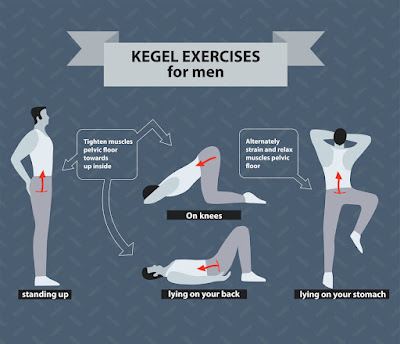Exploring the Foundations: What Are Kegel Exercises and Why Are They Essential for Pelvic Health?

The pelvic floor, often an overlooked area of the body, plays a crucial role in overall health for both men and women. One effective way to maintain the health of this essential region is through Kegel exercises. In this comprehensive guide, we'll explore the reasons why men and women should incorporate Kegel exercises into their routines and provide practical insights into how to perform them.
Understanding the Importance:
The pelvic floor muscles, a network of tissues supporting the pelvic organs, are vital for various bodily functions. For women, these muscles contribute to childbirth and overall reproductive health. In men, a strong pelvic floor is essential for bladder and bowel control, as well as sexual function. Weak pelvic floor muscles can lead to a range of issues, including incontinence, sexual dysfunction, and pelvic organ prolapse.
Benefits for Women:
Preventing and Managing Incontinence: Kegel exercises can significantly reduce the risk of urinary incontinence, a common concern for many women, especially after childbirth or with age.
1. Enhancing Sexual Satisfaction:
Strengthening the pelvic floor muscles contributes to improved muscle tone, leading to heightened sexual sensation and satisfaction.
2. Supporting Reproductive Health:
During pregnancy, Kegel exercises can help prepare the pelvic floor for childbirth, promoting a smoother delivery and aiding in postpartum recovery.
Benefits for Men:
1. Improved Bladder and Bowel Control:
Strengthening the pelvic floor muscles helps prevent and manage issues like urinary incontinence and bowel control problems in men.
2. Enhanced Sexual Function:
Kegel exercises for men are known to improve erectile function and can contribute to better ejaculatory control, leading to a more satisfying sexual experience.
3. Prostate Health:
Regular Kegel exercises can assist in maintaining prostate health, potentially reducing the risk of prostate-related issues.
How to Perform Kegel Exercises:

For Women:
1. Identify the Muscles:
Visualize stopping the flow of urine midstream to locate the pelvic floor muscles.
2. Contract and Hold:
Squeeze the pelvic muscles for a few seconds, then relax.
3. Repeat:
Start with a few repetitions and gradually increase over time.
For Men:

1. Locate the Muscles:
Identify the muscles by stopping the flow of urine midstream or tightening the muscles that prevent passing gas.
2. Contract and Hold:
Squeeze the pelvic muscles for a few seconds, then release.
3. Gradual Progression:
Begin with a comfortable number of repetitions, gradually increasing intensity and duration.
Additional Considerations for Both Genders:
In addition to the core benefits, there are specific considerations for men and women when integrating Kegel exercises into their wellness routines.
For Women:
1. Pregnancy and Postpartum:
Expectant mothers can benefit from incorporating Kegel exercises throughout pregnancy to prepare the pelvic floor for labor. Postpartum, these exercises aid in recovery and restoring pelvic muscle strength.
2. Menopause and Beyond:
As women age, hormonal changes can impact pelvic health. Regular Kegel exercises can mitigate the effects of aging, maintaining muscle tone and preventing issues such as pelvic organ prolapse.
For Men:
1. Prostate Health:
Men, particularly those over 50, can benefit from Kegel exercises to support prostate health. These exercises contribute to improved blood circulation and muscle tone in the pelvic region.
2. Combating Erectile Dysfunction:
Research suggests that Kegel exercises may help men manage and, in some cases, improve erectile dysfunction by enhancing blood flow and strengthening pelvic muscles.

Incorporating Kegel Exercises into Daily Life:
Making Kegel exercises a seamless part of daily life is essential for long-term success. Consider integrating them into routine activities such as sitting at your desk, waiting in line, or even during your daily commute. The discreet nature of these exercises allows for consistent practice without disrupting your schedule.
Progress Tracking and Consistency:
Tracking progress is key to ensuring the effectiveness of Kegel exercises. Maintain a journal, noting the number of repetitions, duration, and any changes in your overall well-being. Consistency is paramount, and over time, you'll likely notice improvements in bladder control, sexual satisfaction, and overall pelvic health.
Seeking Professional Guidance:
While Kegel exercises offer numerous benefits, it's crucial to consult with healthcare professionals, especially if you have pre-existing conditions or concerns. They can provide personalized advice, ensuring that your exercise routine aligns with your individual health needs.
Conclusion:
In the pursuit of overall health, Kegel exercises emerge as a simple yet powerful tool for both men and women. By understanding the unique benefits each gender can derive from these exercises and incorporating them into daily life, individuals can take proactive steps toward maintaining a strong and resilient pelvic floor.
Whether you're preventing issues, seeking enhanced sexual satisfaction, or supporting reproductive health, Kegel exercises are a valuable investment in your overall well-being. Start today, be consistent, and embark on a journey towards a healthier and more empowered you.
